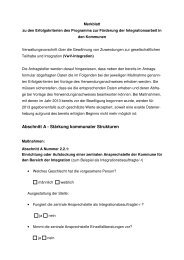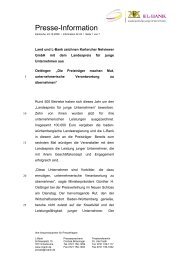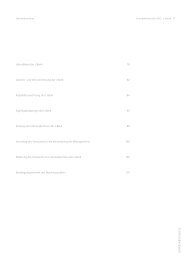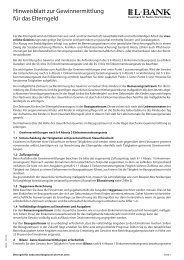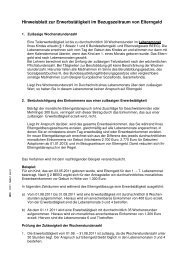Landeskreditbank Baden-Württemberg - L-Bank
Landeskreditbank Baden-Württemberg - L-Bank
Landeskreditbank Baden-Württemberg - L-Bank
Create successful ePaper yourself
Turn your PDF publications into a flip-book with our unique Google optimized e-Paper software.
non-banking corporations if the use of a lower value is advisable in its reasonable commercial<br />
judgment to safeguard against the special risks inherent in the banking business), provided that such<br />
reserves may not exceed 4% of the book value of such receivables and securities;<br />
(8) capital paid in consideration of profit participation rights (Genussrechte) which meets certain<br />
conditions set forth in the German <strong>Bank</strong>ing Act, including subordination to all creditors and<br />
participation in the bank’s losses;<br />
(9) long-term subordinated debt (with a term of at least five years) meeting certain conditions set forth in<br />
the German <strong>Bank</strong>ing Act, including subordination to all non-subordinated creditors;<br />
(10) certain revaluation reserves (banks may allocate amounts equaling a certain percentage of the<br />
difference between the book value and the actual value of certain assets to revaluation reserves; these<br />
revaluation reserves may, in an amount up to 1.4% of the risk-weighted assets and certain off-balance<br />
sheet items, be counted as Liable Capital, if the Core Capital of the bank amounts to at least 4.4% of<br />
such risk-weighted assets and off-balance sheet items); and<br />
(11) reserves pursuant to Section 6b of the German Income Tax Act (Einkommensteuergesetz).<br />
The German <strong>Bank</strong>ing Act also requires that balance sheet losses and certain intangible assets (including<br />
goodwill), certain investments in banks or financial services institutions and certain other items be deducted in<br />
computing Liable Capital.<br />
Core Capital is the portion of Liable Capital set forth in items (1) through (6) above, less balance sheet<br />
losses, certain intangible assets (including goodwill) and certain other items. Supplementary Capital is the<br />
portion of Liable Capital referred to in items (7) through (11), less certain deductions. In our case, Core Capital<br />
consists of (i) paid-in subscribed capital, (ii) retained profit and reserves (including capital surplus) and (iii) the<br />
fund for general bank risks pursuant to Section 340g of the German Commercial Code.<br />
In our case Supplementary Capital consists of (i) long-term subordinated debt, (ii) profit participation<br />
capital and (iii) reserves for general bank risks pursuant to Section 340f of the German Commercial Code. The<br />
German <strong>Bank</strong>ing Act provides that the aggregate amount of Supplementary Capital must not exceed the Core<br />
Capital. In addition, the sum of long-term subordinated debt must not exceed 50% of the Core Capital. Core<br />
Capital reflects the same concept as Tier I Capital and Supplementary Capital reflects a similar concept as Tier II<br />
Capital (as such terms are used in the United States capital adequacy rules).<br />
Risk Weighted Assets and Off-Balance Sheet Items<br />
To compute risk-weighted assets (the first part of the denominator of the Solvency Ratio), the assets of a<br />
bank are assigned to six broad categories (0%, 10%, 20%, 50%, 70% and 100%) of relative credit risk depending<br />
on the debtor or on the type of instrument or collateral securing the asset. The valuation basis of each asset, being<br />
its book value subject to certain accounting adjustments, is multiplied by the percentage weight applicable to its<br />
risk category to arrive at the risk-weighted value.<br />
The valuation basis for computing risk-weighted off-balance sheet items (the second part of the denominator<br />
of the Solvency Ratio) depends on the type of the off-balance sheet item. The valuation basis (1) for swap<br />
transactions and any credit support obligation assumed in connection therewith is the principal amount or — in<br />
absence of such principal amount — the current market value of the underlying asset, and (2) for forward or<br />
futures contracts and rights under option agreements and any credit support obligation assumed in connection<br />
therewith, the current market value of the right of the bank to obtain delivery or of the obligation of the<br />
counterparty to accept delivery of the underlying asset assuming actual performance of the contract. For all other<br />
off-balance sheet items, the valuation basis is their book value subject to certain accounting adjustments.<br />
To compute risk-weighted off-balance sheet items (the second part of the denominator of the Solvency<br />
Ratio), different rules apply depending on the type of off-balance sheet items. The valuation basis of off-balance<br />
38



